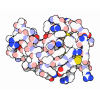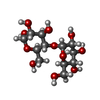+ Open data
Open data
- Basic information
Basic information
| Entry | Database: PDB / ID: 7bvq | ||||||
|---|---|---|---|---|---|---|---|
| Title | Structure of human beta1 adrenergic receptor bound to carazolol | ||||||
 Components Components | Endolysin,Beta-1 adrenergic receptor chimera | ||||||
 Keywords Keywords |  MEMBRANE PROTEIN / MEMBRANE PROTEIN /  G protein coupled receptor / G protein coupled receptor /  SIGNALING PROTEIN SIGNALING PROTEIN | ||||||
| Function / homology |  Function and homology information Function and homology informationviral release from host cell by cytolysis / peptidoglycan catabolic process / cell wall macromolecule catabolic process /  lysozyme / lysozyme /  lysozyme activity / host cell cytoplasm / defense response to bacterium lysozyme activity / host cell cytoplasm / defense response to bacteriumSimilarity search - Function | ||||||
| Biological species |   Enterobacteria phage T4 (virus) Enterobacteria phage T4 (virus)  Homo sapiens (human) Homo sapiens (human) | ||||||
| Method |  X-RAY DIFFRACTION / X-RAY DIFFRACTION /  SYNCHROTRON / SYNCHROTRON /  MOLECULAR REPLACEMENT / Resolution: 2.5 Å MOLECULAR REPLACEMENT / Resolution: 2.5 Å | ||||||
 Authors Authors | Xu, X. / Kaindl, J. / Clark, M. / Hubner, H. / Hirata, K. / Sunahara, R. / Gmeiner, P. / Kobilka, B.K. / Liu, X. | ||||||
 Citation Citation |  Journal: Cell Res. / Year: 2021 Journal: Cell Res. / Year: 2021Title: Binding pathway determines norepinephrine selectivity for the human beta 1 AR over beta 2 AR. Authors: Xu, X. / Kaindl, J. / Clark, M.J. / Hubner, H. / Hirata, K. / Sunahara, R.K. / Gmeiner, P. / Kobilka, B.K. / Liu, X. | ||||||
| History |
|
- Structure visualization
Structure visualization
| Structure viewer | Molecule:  Molmil Molmil Jmol/JSmol Jmol/JSmol |
|---|
- Downloads & links
Downloads & links
- Download
Download
| PDBx/mmCIF format |  7bvq.cif.gz 7bvq.cif.gz | 216 KB | Display |  PDBx/mmCIF format PDBx/mmCIF format |
|---|---|---|---|---|
| PDB format |  pdb7bvq.ent.gz pdb7bvq.ent.gz | 154.9 KB | Display |  PDB format PDB format |
| PDBx/mmJSON format |  7bvq.json.gz 7bvq.json.gz | Tree view |  PDBx/mmJSON format PDBx/mmJSON format | |
| Others |  Other downloads Other downloads |
-Validation report
| Arichive directory |  https://data.pdbj.org/pub/pdb/validation_reports/bv/7bvq https://data.pdbj.org/pub/pdb/validation_reports/bv/7bvq ftp://data.pdbj.org/pub/pdb/validation_reports/bv/7bvq ftp://data.pdbj.org/pub/pdb/validation_reports/bv/7bvq | HTTPS FTP |
|---|
-Related structure data
| Related structure data | 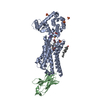 7btsC 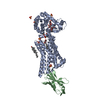 7bu6C  7bu7C 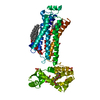 2rh1S S: Starting model for refinement C: citing same article ( |
|---|---|
| Similar structure data |
- Links
Links
- Assembly
Assembly
| Deposited unit | 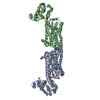
| ||||||||||||
|---|---|---|---|---|---|---|---|---|---|---|---|---|---|
| 1 | 
| ||||||||||||
| 2 | 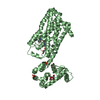
| ||||||||||||
| Unit cell |
|
- Components
Components
-Protein / Sugars , 2 types, 3 molecules AB
| #1: Protein | Mass: 52235.879 Da / Num. of mol.: 2 / Mutation: C944T,C987A Source method: isolated from a genetically manipulated source Details: 1261 Cys to 1314 LEU are truncated region.,1261 Cys to 1314 LEU are truncated region. Source: (gene. exp.)   Enterobacteria phage T4 (virus), (gene. exp.) Enterobacteria phage T4 (virus), (gene. exp.)   Homo sapiens (human) Homo sapiens (human)Gene: e, T4Tp126 / Production host:   Spodoptera frugiperda (fall armyworm) / References: UniProt: D9IEF7, Spodoptera frugiperda (fall armyworm) / References: UniProt: D9IEF7,  lysozyme lysozyme#2: Polysaccharide | alpha-D-glucopyranose-(1-4)-alpha-D-glucopyranose / alpha-maltose | |
|---|
-Non-polymers , 8 types, 141 molecules 
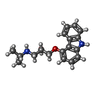



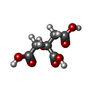
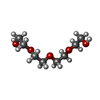








| #3: Chemical | ChemComp-CLR /  Cholesterol Cholesterol | ||||||||||||
|---|---|---|---|---|---|---|---|---|---|---|---|---|---|
| #4: Chemical | | #5: Chemical | ChemComp-SO4 /  Sulfate Sulfate#6: Chemical | #7: Chemical | ChemComp-NA / | #8: Chemical |  Citric acid Citric acid#9: Chemical | ChemComp-PG4 /  Polyethylene glycol Polyethylene glycol#10: Water | ChemComp-HOH / |  Water Water |
-Details
| Has ligand of interest | Y |
|---|---|
| Sequence details | THE GENEBANK ENTRY NP_000675 IS A REFERENCE SEQUENCE FOR THE RESIDUES FROM 171TH TO 462TH OF OF CHAIN A. |
-Experimental details
-Experiment
| Experiment | Method:  X-RAY DIFFRACTION / Number of used crystals: 1 X-RAY DIFFRACTION / Number of used crystals: 1 |
|---|
- Sample preparation
Sample preparation
| Crystal | Density Matthews: 3.43 Å3/Da / Density % sol: 64.12 % |
|---|---|
Crystal grow | Temperature: 293 K / Method: lipidic cubic phase Details: 100 mM Sodium citrate, pH 5, 150-170 mM lithium sulfate, 38-42% PEG300, 3% 1,3-butanediol |
-Data collection
| Diffraction | Mean temperature: 80 K / Serial crystal experiment: N |
|---|---|
| Diffraction source | Source:  SYNCHROTRON / Site: SYNCHROTRON / Site:  SPring-8 SPring-8  / Beamline: BL32XU / Wavelength: 1 Å / Beamline: BL32XU / Wavelength: 1 Å |
| Detector | Type: DECTRIS EIGER X 9M / Detector: PIXEL / Date: Apr 9, 2018 |
| Radiation | Monochromator: liquid nitrogen-cooled double crystal Si(111) Protocol: SINGLE WAVELENGTH / Monochromatic (M) / Laue (L): M / Scattering type: x-ray |
| Radiation wavelength | Wavelength : 1 Å / Relative weight: 1 : 1 Å / Relative weight: 1 |
| Reflection | Resolution: 2.5→50 Å / Num. obs: 46879 / % possible obs: 99.7 % / Redundancy: 33.3 % / Biso Wilson estimate: 46.84 Å2 / CC1/2: 0.997 / Net I/σ(I): 11.01 |
| Reflection shell | Resolution: 2.5→2.6 Å / Num. unique obs: 5182 / CC1/2: 0.486 |
- Processing
Processing
| Software |
| ||||||||||||||||||||||||||||||||||||||||||||||||||||||||||||||||||||||||||||||||||||||||||||||||||||||||||||||||||||||||||||||
|---|---|---|---|---|---|---|---|---|---|---|---|---|---|---|---|---|---|---|---|---|---|---|---|---|---|---|---|---|---|---|---|---|---|---|---|---|---|---|---|---|---|---|---|---|---|---|---|---|---|---|---|---|---|---|---|---|---|---|---|---|---|---|---|---|---|---|---|---|---|---|---|---|---|---|---|---|---|---|---|---|---|---|---|---|---|---|---|---|---|---|---|---|---|---|---|---|---|---|---|---|---|---|---|---|---|---|---|---|---|---|---|---|---|---|---|---|---|---|---|---|---|---|---|---|---|---|---|
| Refinement | Method to determine structure : :  MOLECULAR REPLACEMENT MOLECULAR REPLACEMENTStarting model: 2rh1 Resolution: 2.5→19.79 Å / SU ML: 0.3512 / Cross valid method: FREE R-VALUE / σ(F): 1.93 / Phase error: 26.4209 Stereochemistry target values: GeoStd + Monomer Library + CDL v1.2
| ||||||||||||||||||||||||||||||||||||||||||||||||||||||||||||||||||||||||||||||||||||||||||||||||||||||||||||||||||||||||||||||
| Solvent computation | Shrinkage radii: 0.9 Å / VDW probe radii: 1.11 Å / Solvent model: FLAT BULK SOLVENT MODEL | ||||||||||||||||||||||||||||||||||||||||||||||||||||||||||||||||||||||||||||||||||||||||||||||||||||||||||||||||||||||||||||||
| Displacement parameters | Biso mean: 72.69 Å2 | ||||||||||||||||||||||||||||||||||||||||||||||||||||||||||||||||||||||||||||||||||||||||||||||||||||||||||||||||||||||||||||||
| Refinement step | Cycle: LAST / Resolution: 2.5→19.79 Å
| ||||||||||||||||||||||||||||||||||||||||||||||||||||||||||||||||||||||||||||||||||||||||||||||||||||||||||||||||||||||||||||||
| Refine LS restraints |
| ||||||||||||||||||||||||||||||||||||||||||||||||||||||||||||||||||||||||||||||||||||||||||||||||||||||||||||||||||||||||||||||
| LS refinement shell |
|
 Movie
Movie Controller
Controller



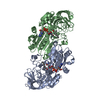


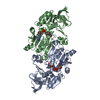
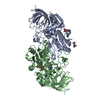
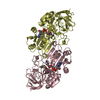

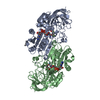
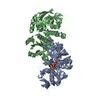
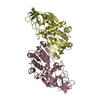
 PDBj
PDBj

